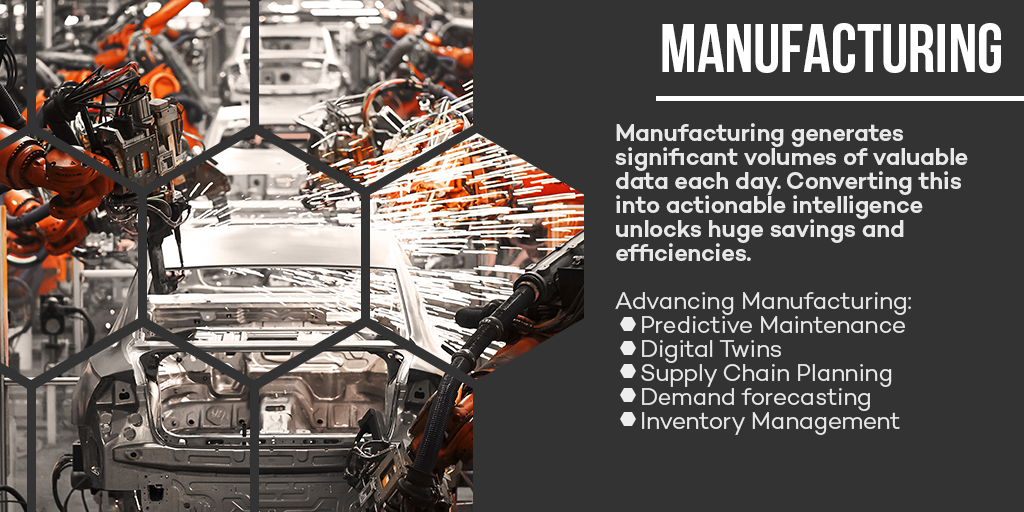Overcoming Manufacturing Industry Challenges with Big Data. Demand Forecasting Case study
Manufacturing is an industry that is increasingly turning to data and artificial intelligence (AI) to improve operations and stay competitive. With the help of data and AI, manufacturers can gain insights, automate processes, and make better decisions. In this blog post, we will explore some common use cases for data and AI in manufacturing and the benefits they can bring.
Predictive Maintenance: One of the most common use cases for data and AI in manufacturing is predictive maintenance. By analysing sensor data from machines and equipment, manufacturers can predict when maintenance is needed before a breakdown occurs. This can help manufacturers avoid unplanned downtime and increase equipment uptime, leading to cost savings and increased efficiency.
Quality Control: Another common use case for data and AI in manufacturing is quality control. By analysing sensor data and images, manufacturers can detect defects in products and take corrective action before they reach the customer. This can help manufacturers improve product quality and reduce costs associated with defective products.
Supply Chain Optimization: Data and AI can also be used to optimize supply chain operations. By analysing data on inventory levels, demand, and shipping schedules, manufacturers can optimize production schedules and reduce costs associated with overproduction and stockouts.
Predictive Sales: Data and AI can also be used to predict sales and demand. By analysing data on customer behaviour, manufacturers can predict demand for products and adjust production schedules accordingly. This can help manufacturers reduce costs associated with overproduction and stockouts.
Automated Processes: Data and AI can also be used to automate processes in manufacturing. By using machine learning algorithms, manufacturers can automate tasks such as product sorting and packaging, which can increase efficiency and reduce costs.
The benefits of using data and AI in manufacturing are numerous. By using data and AI, manufacturers can improve operations, increase efficiency, and reduce costs. They can also gain insights into customer behaviour and demand, which can help them make better decisions and stay competitive in the market.
Demand Forecasting
Improving outcomes with AI
CASE STUDY: Manufacturing Rental Company. Demand Forecasting
As businesses continue to evolve and adapt to the ever-changing market, many are turning to Artificial Intelligence (AI) to boost commercial growth. Advancing Analytics' customer, a leading UK supplier of plant, tools, and specialist equipment hire, is no exception. This company wanted to leverage AI to better understand, predict, and automate their depot stock levels in order to stay competitive in the market.
The core business of this equipment hire company is driven by customers renting items of equipment, ranging from hand-held tools to several-tonne pieces of equipment. Managing the stock levels of these assets is a critical aspect of the business, as it is crucial to ensure that the right assets are available at the right time to avoid depletion. At the same time, it is equally important to avoid overstocking assets, which can be cost-prohibitive.
Traditionally, the company has been using manual forecasting of demand and utilization, which has been limited to a couple of days. This poses a significant challenge for the company, as it makes it difficult to accurately predict future demand and stock levels. By turning to AI, the company can improve the accuracy and timeliness of their predictions, which can help them to better manage their stock levels and avoid costly overstocking.
AI can also be used to automate the process of forecasting demand and stock levels. By using machine learning algorithms, the company can analyze data on past demand and utilization and use this information to predict future demand and stock levels. This can help the company to make more informed decisions about stock levels and avoid costly mistakes.
Data Lakehouse made easy
Rapid lake hydration with Hydr8
When it comes to leveraging Artificial Intelligence (AI) and Machine Learning (ML) to boost business growth, it's important to have the right architecture in place. Advancing Analytics understands this, which is why they deployed their team of Machine Learning Architects and Data Engineers to devise the best AI/ML architecture to meet the goals of their customer, a leading UK supplier of plant, tools, and specialist equipment hire.
After a short discovery phase using Advancing Analytics' Analytics Platform process, the team gathered the requirements to design a platform that would support the development, deployment, and management of Machine Learning models in production. They then used their own Hydr8 framework deployed on Microsoft's Azure Cloud Platform to rapidly onboard data from several diverse sources to establish the data required to forecast demand efficiently.
Azure Databricks was used to develop forecasting algorithms based on seasonality, locality, weather, and popularity, to ensure high levels of accuracy. These models were then managed in production using a combination of MLFlow and the Rendezvous approach to Machine Learning model deployment.
The use of the Hydr8 framework and Azure Cloud Platform allowed Advancing Analytics to quickly and easily onboard data from multiple sources, giving their customer the data, they needed to forecast demand efficiently. The use of Azure Databricks and MLFlow ensured that the models developed were accurate, and that they could be easily managed in production.
In conclusion, Advancing Analytics' team of Machine Learning Architects and Data Engineers worked closely with their customer to design a platform that would support the development, deployment, and management of Machine Learning models in production. Using their own Hydr8 framework deployed on Microsoft's Azure Cloud Platform, they were able to quickly onboard data from multiple sources and develop accurate forecasting algorithms. With the help of MLFlow, they were also able to easily manage the models in production, ensuring that the customer's goals were met.



